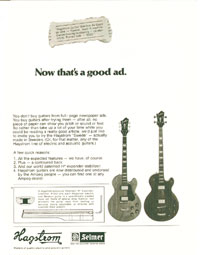
The Hagstrom Swede bass launched in 1971, a companion to the Swede guitar launched a year earlier in 1970. Like all Hagstroms of this time it was built at the Hagstrom guitar factory in Älvdalen, Sweden. A total of 1479 basses were produced between 1971 and 1976 in six batches, with another 200 Swede Patch basses shipping in two batches in 1970. Another model, the Super Swede followed in 1980-81, though this bore no resemblance to the previous Swede models.
Hagstrom had typically used Birch or Mahogany for their basses, and some, like the H8 were available in either wood. The Swede was all-mahogany (like the Coronado) but with a nice ebony fretboard with block inlays, and fancy headstock inlays. The 1972 Hagstrom brochure describes these as mother-of-pearl, though by 1974 this was described as pearloid.
The Swede and Swede bass were no doubt created in response to the popularity of the Gibson Les Paul, which after a brief pause had been reissued in 1968. But Gibson had only launched the Les Paul bass in 1969, replacing it with the Triumph bass in 1971 - both equipped with low impedance pickups and circuitry. The Hagstrom Swede bass obviously takes some design cues from these Gibson basses, sharing a short scale, mahogany body and neck, humbucking pickups and (somewhat) advanced tone circuitry. But there were some key differences, notably the bolt-on neck (Gibson basses typically had a set neck), and the ebony fretboard (Gibson used rosewood).
The Swede bass was an expensive bass - Hagstrom's most expensive. In early 1974, it was listed at $499.50 (case $95), the Gibson Triumph (also their most expensive bass at the time) was listed at $580 (case $93). By comparison, the Fender Precision / Jazz basses were listed at $293.50 and $356.50 respectively.
When the Swede bass was launched in late 1971, Hagstrom distribution was in turmoil. Deals with Merson / Unicord in the USA and Rosetti in the UK had ceased and a new deal with Canadian company ARC had not yet been realised. It is not clear why the short-lived worldwide distribution deal with ARC was so unsuccessful: bad management at ARC? a lack of production in Sweden? Perhaps ARC just bit off more than it could chew? No doubt compounded with problems relating to the financial crisis of 1973. In any case, when Ampeg took over in January 1974 they gave the bass model designation HB 903. In their first publicity material they described the brand as "the legendary Swedish guitars only a lucky few could find", adding "...until now Hagstroms were hard to find it this country". Ampeg did significantly improve the availability of Hagstrom guitars, but by the time they had, short-scale mahogany basses were somewhat passé. The Swede really was a great bass, but it never made the mark that perhaps it should.
“Truly a professional precision instrument. Two booming bass pickups covering all ranges of sound required in the music of today. Two 3 position switches as in the "Swede" guitar. Ultra fast ebony neck with beautiful mother-of-pearl inlays. A rich cherry red, wood grain finish unequaled in its field. Definitely a bass for the discriminating musician.”
“Two booming bass pickups give the Swede both the power and the wide tonal range required for music in any contemporary style. One 3-position switch gives you a choice of the first pick up, the second, or both. Another gives a choice of three distinct tone qualities independently of the pickups in use. The neck is contoured for keeping pace with the fastest fingering at your command.
Like all Swedish Hagstrom guitars, the first three digits of the serial number are the batch number, which tells us the year of production, and the size of the batch. The data is reproduced below.
| Model | Serial number | Year of production | Quantity |
|---|---|---|---|
| Swede | 815 | 1971-72 | 250 |
| Swede | 827 | 1972-73 | 149 |
| Swede | 870 | 1973 | 100 |
| Swede | 914 | 1974 | 180 |
| Swede | 933 | 1974-75 | 500 |
| Swede | 934 | 1976 | 300 |
| Swede Patch | 993 | 1977 | 75 |
| Swede Patch | 999 | 1977 | 125 |
Electric bass advertisements originally published from 1974 onwards. Click on the images for larger copies. Check out other vintage Hagstrom advertisements

Hagstrom Swede - Now that's a good ad. (1974)
Black and white advert for the Hagstrom Swede guitar and Swede bass from the June 1974 issue of Guitar Player magazine. It features a classified ad clipping: "Hagstrom Guitar Electric As Good as ne...
[more]
The Hagstrom Swede bass is a really nice instrument, beautifully-made, nicely appointed, and with a wide range of sounds. But like many vintage guitars, there are some issues that are worth considering. I would not let any of the following issues prevent me from buying a Swede bass, but they are certainly worth mentioning.
Firstly is the weight. This example weighs 4.79kg - which although not exceptionally heavy, and comparable to the Gibson Les Paul Triumph bass (this one weighs 4.93kg, for example), but is quite a lot heavier than many other short-scale basses: EB-0 / EB-3 basses typically range between 3.5kg and 4kg.
Compared to some basses it is also quite difficult to set up. Although the bridge / tailpiece combination is far better than those fitted to previous Hagstroms, it still lacks some of the range of some better (typically newer) bridge designs, and making adjustments, although not that difficult, is certainly not trivial. Read more about the Hagstrom Swede bass bridge.
One final issue very common with these basses is the fragility of the pickup surrounds. They are especially prone to breaking, often splitting around the screw holes or falling apart entirely. Swede basses (and other Hagstroms using the same part) are often seen with incomplete pickup mounting rings!